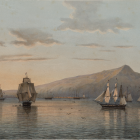The second half of the nineteenth century was a time of expanding telegraphic connections around the world, and Southeast Asia was no exception. The Dutch colonial administration was keen to link up its possessions to the global network at Singapore. The first undersea cable connecting the colonial capital Batavia (now Jakarta) with Singapore was laid in 1859 but failed almost immediately.
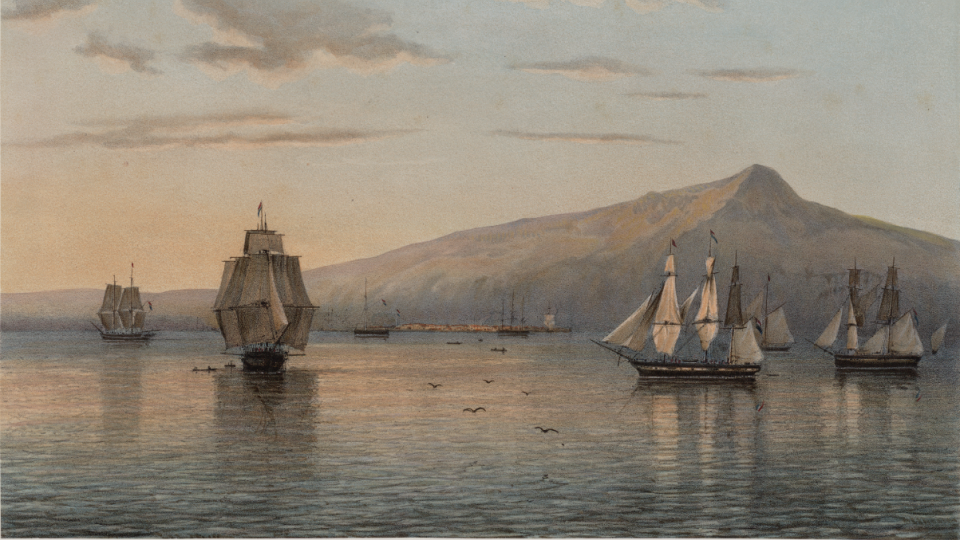
Painting of the Anyer shoreline with sailing ships. Abraham Salm, Anjer, Noordkust van Java (Residentie Bantam), 1872.
Painting of the Anyer shoreline with sailing ships. Abraham Salm, Anjer, Noordkust van Java (Residentie Bantam), 1872.
Courtesy of Leiden University Libraries Digital Collections. Click here to view source.
 This work is licensed under a Creative Commons Attribution 4.0 International License.
This work is licensed under a Creative Commons Attribution 4.0 International License.
The Dutch then turned to the Sunda Strait as an alternative route, as the majority of the cable could be drawn overland through Sumatra, making faults easier to locate and fix. In 1863 it was decided to connect the town of Anyer on the north coast of Java and Teluk Betung on the southern tip of Sumatra. The history of that connection, littered with frustrations and mishaps, runs for two decades, and charts a complex story of human and technological engagement with the coastal ecology of the Sunda Strait.
The first attempt to establish the connection, in the autumn of 1865, had to be postponed due to unspecified faults in the cable and the impending monsoon season. Much delayed, it was finally in working order in November 1866, but remained patchy, functioning for only 237 days in 1867 and breaking down completely in March 1868, with a new line laid only in 1871. That record never really improved: in 1876, the connection was down from January to July; in 1878, from January to May. And such major breakages were in addition to a continuous trickle of smaller faults and disruptions.
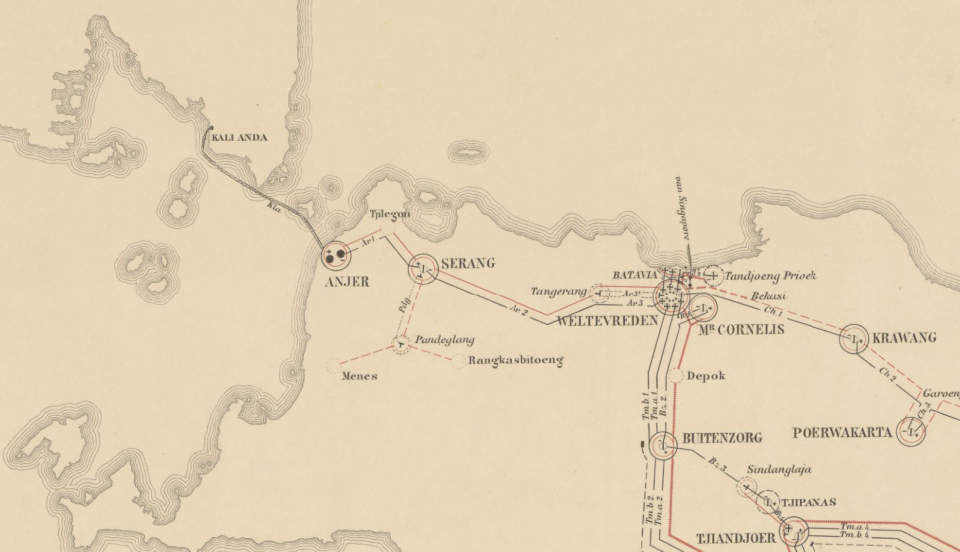
Detail of a telegraph map of Java and Madura, showing the connection across the Sunda Strait, 1887.
Detail of a telegraph map of Java and Madura, showing the connection across the Sunda Strait, 1887.
Courtesy of Leiden Library Universities Digital Collections. Click here to view source.
 This work is licensed under a Creative Commons Attribution 4.0 International License.
This work is licensed under a Creative Commons Attribution 4.0 International License.
Nineteenth-century telegraphy is often seen as the beginning of “a historically unprecedented world wide web,” to quote Jürgen Osterhammel. Elsewhere, Roland Wenzlhuemer has highlighted the telegraph’s “dematerialization of long-distance information flows.” These are macro-level abstractions that accurately describe the bigger picture despite the relatively common breakages and disruptions that bedeviled that progress, not just in the Sunda Strait but globally. Nevertheless, a more locally specific analysis of cases like this—an environmental history of the telegraph foregrounding materiality and locality—helps to draw attention to the very real frustrations and necessary adaptations that long-term processes entailed in specific contexts. It provides a reminder that revolutionary progress does not always feel like that on the ground.
What, then, caused all these disruptions? Many things, most of them somehow connected to the local ecology. In 1873 the cable was found—to everyone’s surprise—to be damaged by “white ants,” i.e. termites, that had got through the iron protection and eaten into the insulation. This was to be a recurring problem: as Rohan Deb Roy has recently shown, termites were a constant threat to colonial infrastructure. A little later the connection was again cut by the anchor of an American ship. In 1876, repairs were delayed by the heavy growth of coral that had attached to the cable. An 1879 report notes Teredo shipworms as a further cause of damage.
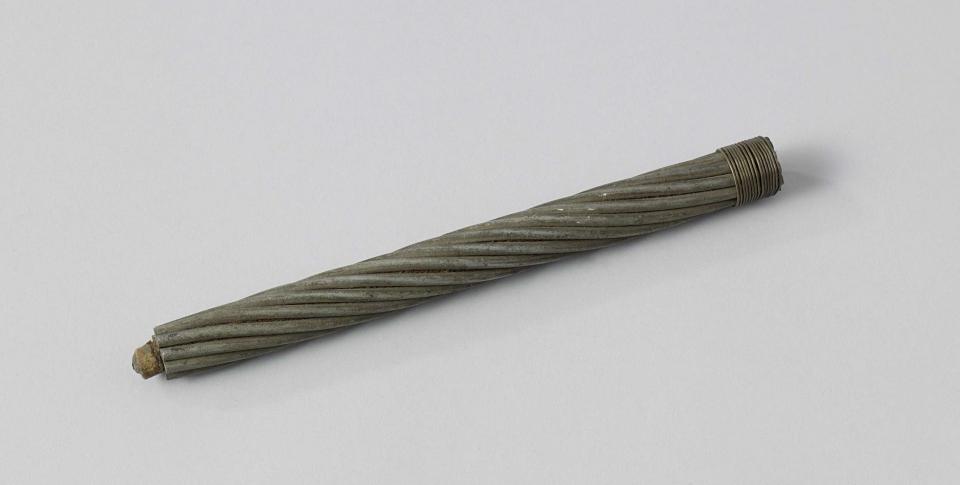
A section of telegraph cable, the copper wire protected by a layer of (probably) gutta-percha and paper, with steel on the outside, ca. 1865–1875.
A section of telegraph cable, the copper wire protected by a layer of (probably) gutta-percha and paper, with steel on the outside, ca. 1865–1875.
Courtesy of Rijksmuseum. Click here to view source.
 This work is licensed under a Creative Commons Public Domain Mark 1.0 License.
This work is licensed under a Creative Commons Public Domain Mark 1.0 License.
The story of the Anyer to Teluk Betung underwater cable could be told as one of technology versus nature, the termites, shipworms, and corals representing local environmental obstacles to manmade globalization. Yet this is far too simplistic. On the one hand, technology was also a risk factor, as anchors from the busy traffic in the strait could—and did—cut into the cables. Notices were published to warn ships away, and guilty parties pursued for compensation through foreign consuls. Technological globalization could also be its own enemy.
On the other hand, the cable itself can be seen as a product of the local environment. The insulating layers—the organic components vulnerable to termites and worms—were made of gemoetie, palm fiber-based rope long used locally and adopted by the colonizer; or of gutta-percha, a rubber-like material produced from the sap of Palaquium gutta, a tree species native to the region (the Malay word perca even refers to Sumatra). Indeed, gutta-percha’s usefulness for insulating undersea cables made it a key global commodity in the late nineteenth century. In Southeast Asia, the local environment provided both the materials for new connections as well as a threat to their integrity: the cable was a part of the local ecology, not just an external imposition.
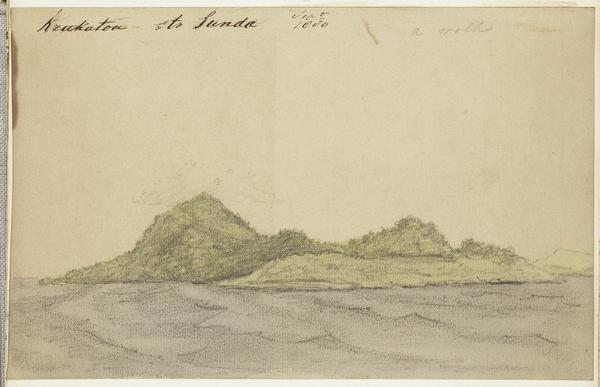
Illustration of the volcano Krakatau in the Sunda Strait. Drawing by O.G.H. Heldring, 1880.
Illustration of the volcano Krakatau in the Sunda Strait. Drawing by O.G.H. Heldring, 1880.
Courtesy of Leiden University Libraries Digital Collections. Click here to view source.
 This work is licensed under a Creative Commons Attribution 4.0 International License.
This work is licensed under a Creative Commons Attribution 4.0 International License.
The final break in the Anyer to Teluk Betung connection was also by far the most dramatic: the massive eruption of the Krakatau volcano in 1883 severed the cable and laid waste to both towns. The chief of the Anyer telegraph office was reported drowned, one of tens of thousands of deaths. This was as clear a reminder as could be imagined of the inability of colonial planning to control the local environment. It also represented the end to this particular project: when the connection was re-laid, a slightly different route was chosen, by-passing Teluk Betung.
The case of the Sunda Strait cable challenges the conventional interpretation of coastal environments as connective spaces, where maritime mobilities bring people together and open up opportunities for trade and cultural exchange. That exceedingly positive narrative needs to be tempered and supplemented with the acknowledgment of a stubborn and recurrent dynamic of coastal disconnectivity: the coast as a site of breakage, environmental disruption, and information loss; as a limit, even if only local and fleeting, in the horizons of globalization.
PRIMARY SOURCES
-
“Batavia.” De Oostpost, 3 October 1865.
-
“Het telegraafnet in Nederl. Indie.” Bataviaasch Handelsblad, 27 April 1867.
-
“Telegrafie in N. Indie.” Java-Bode, 7 April 1870.
-
“Verslag omtrent den Gouvernements Telegraaf in Nederlandsch-Indië over 1873.” Bataviaasch Handelsblad, 4 May 1875.
-
“Mail-overzicht.” Java-Bode, 17 July 1876.
-
“De post- en telegraafdienst in 1878.” Sumatra-Courant, 22 November 1879.
-
“Telegrammen.” De Locomotief, 29 August 1883.
How to cite
Toivanen, Mikko. “Disconnectivity in the Age of Globalization: Coastal Ecology, Telegraphy, and Empire in the Sunda Strait, 1863–1883.” Environment & Society Portal, Arcadia (Summer 2021), no. 28. Rachel Carson Center for Environment and Society. doi:10.5282/rcc/9343
ISSN 2199-3408
Environment & Society Portal, Arcadia
 This work is licensed under a Creative Commons Attribution 4.0 International License.
This work is licensed under a Creative Commons Attribution 4.0 International License.
2021 Mikko Toivanen
This refers only to the text and does not include any image rights.
Please click on the images to view their individual rights status.
- Deb Roy, Rohan. “White Ants, Empire and Entomo-Politics in South Asia.” The Historical Journal 63, no. 2 (2020): 411–436. doi:10.1017/S0018246X19000281
- Goh Chor Boon. Technology and Entrepôt Colonialism in Singapore, 1819–1940. Singapore: Institute of Southeast Asian Studies, 2013.
- Osterhammel, Jürgen. The Transformation of the World: A Global History of the Nineteenth Century. Princeton: Princeton University Press, 2014.
- Ravesteijn, Wim, and Marie-Louise ten Horn-van Nispen. “Engineering an Empire: The Creation of Infrastructural Systems in the Netherlands East Indies 1800–1950.” Indonesia and the Malay World 35, no. 103 (2007): 273–292. doi:10.1080/13639810701676631
- Skabelund, Aaron. “Animals and Imperialism: Recent Historiographical Trends.” History Compass 11, no. 10 (2013): 801–807. doi:10.1111/hic3.12093
- Wenzlhuemer, Roland. Connecting the Nineteenth-Century World: The Telegraph and Globalization. Cambridge: Cambridge University Press, 2013.



